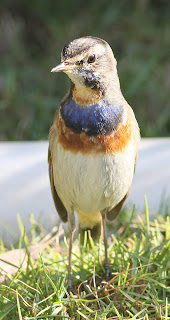Things were very quiet at Pilling this morning, both in the trees and on the pools, the Tufted Duck with 5 young to the east with 4 Little Grebe and a Little Egret on the west pool. The Kestrels were around again, but only 2 of three local youngsters this morning and playing at Hobbies, or at least the Swallows and House Martins thought so. As the two Kestrels hunted up and down the sea wall they did so to an entourage of twittering hirundines.


In the absence of any tidal movement my bird counts up at Pilling Water and beyond were low again; 2 Common Sandpiper, 1 Grey Heron, 90+Lapwing, 40 Curlew, 6 Greenfinch, 7 Linnet, 8 Goldfinch, 2 Pied/Alba Wagtail, 2 Stock Dove, 12 Skylark, another Kestrel, 8 Swift and 2 Meadow Pipit. There was absolutely nothing on the wildfowler’s now dried up again pools, and the planned for half day trek became a flying visit.
Things were so quiet at Pilling that I spent a few hours doing essential maintenance at Our Rawcliffe moss ringing site in preparation for weekend ringing. It was mainly beating back rampant bramble and willowherb from mist net rides and our pathways, together with a little judicial tree pruning. Naturally I had a look around and found the expected array of birds in the plantation and along the hedgerows with 2 Blackcap, 5 Willow Warbler, 7 Whitethroat, 5 Skylark, 12 Tree Sparrow, 30 Goldfinch, 2 Linnet and 1 Corn Bunting. The latter appears still to be the only singing male on the extensive farm this year, with one brood of youngsters so far.

In this area of West Lancashire, known as the Fylde, the breeding population of Corn Bunting in 2011 appears to be at critically low levels, the lowest I have seen in thirty years of local birding and ringing. In some years a small wintering or even spring gathering of Corn Buntings appears on local mosses. However these may not be individuals from the very scarce Fylde breeding population and in the absence of any meaningful studies of these transient birds no one can be sure if any of them originate from Lancashire or even the North West of the UK.
I also saw 3 Yellowhammer, another Fylde species clinging on to existence in a similar way to the Corn Bunting; both species could now be classified as “very scarce and localised breeders” – how sad. The Yellowhammers were in the process of feeding young, probably a second brood by now, but with the size of the food items the female brought in, I decided not to look for a nest.


Other birds: 40 Lapwing, 3 Buzzard, 100+ Swallow over the silage and barley fields, 4 Swift, 1 Great-spotted Woodpecker, 1 Tawny Owl, 1 Little Owl and 1 Kestrel.

































































